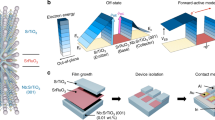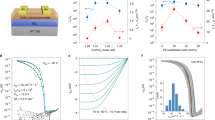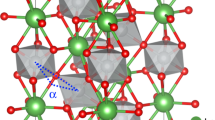Abstract
‘More than Moore’1 captures a concept for overcoming limitationsin silicon electronics by incorporating new functionalitiesin the constituent materials. Perovskite oxides are candidates because of their vast array of physical properties in a common structure. They also enable new electronic devices based on strongly-correlated electrons2. The field effect transistor3 and its derivatives have been the principal oxide devices investigated thus far4,5,6, but another option is available in a different geometry: if the current is perpendicular to the interface, the strong internal electric fields generated at back-to-back heterojunctions can be used for oxide electronics, analogous to bipolar transistors7. Here we demonstrate a perovskite heteroepitaxial metal-base transistor8 operating at room temperature, enabled by interface dipole engineering9. Analysis of many devices quantifies the evolution from hot-electron10 to permeable-base11 behaviour. This device provides a platform for incorporating the exotic ground states of perovskite oxides, as well as novel electronic phases at their interfaces12,13,14,15.
This is a preview of subscription content, access via your institution
Access options
Subscribe to this journal
Receive 12 print issues and online access
$259.00 per year
only $21.58 per issue
Buy this article
- Purchase on Springer Link
- Instant access to full article PDF
Prices may be subject to local taxes which are calculated during checkout





Similar content being viewed by others
References
The International Technology Roadmap for Semiconductors: http://www.itrs.net.
Takagi, H. & Hwang, H. Y. An emergent change of phase for electronics. Science 327, 1601–1602 (2010).
Kahng, D. & Atalla, M. M. IEEE-AIEE Solid-State Device Res. Conf. (Carnegie Inst. of Tech., 1960).
Mannhart, J., Schlom, D. G., Bednorz, J. G. & Muller, K. A. Influence of electric fields on pinning in YBa2Cu3O7−δ films. Phys. Rev. Lett. 67, 2099–2101 (1991).
Takahashi, K. S. et al. Local switching of two-dimensional superconductivity using the ferroelectric field effect. Nature 441, 195–198 (2006).
Ueno, K. et al. Electric-field-induced superconductivity in an insulator. Nature Mater. 7, 855–858 (2008).
Schockley, W., Sparks, M. & Teal, G. K. p–n junction transistors. Phys. Rev. 83, 151–162 (1951).
Mead, C. A. Operation of tunnel-emission devices. J. Appl. Phys. 32, 646–652 (1961).
Hikita, Y., Nishikawa, M., Yajima, T. & Hwang, H. Y. Termination control of the interface dipole in La0.7Sr0.3MnO3/Nb:SrTiO3(001) Schottky junctions. Phys. Rev. B 79, 073101 (2009).
Sze, S. M., Crowell, C. R., Carey, G. P. & LaBate, E. E. Hot electron transport in semiconductor–metal–semiconductor structures. J. Appl. Phys. 37, 2690–2695 (1966).
Bozler, C. O. & Alley, G. D. Fabrication and numerical simulation of the permeable base transistor. IEEE Trans. Electron Devices ED-27, 1128–1141 (1980).
Ohtomo, A., Muller, D. A., Grazul, J. L. & Hwang, H. Y. Artificial charge-modulation in atomic-scale perovskite titanate superlattices. Nature 419, 378–380 (2002).
Ohtomo, A. & Hwang, H. Y. A high-mobility electron gas at the LaAlO3/SrTiO3 heterointerface. Nature 427, 423–426 (2004).
Smadici, S. et al. Electronic reconstruction at SrMnO3–LaMnO3 superlattice interfaces. Phys. Rev. Lett. 99, 196404 (2007).
Gozar, A. et al. High-temperature interface superconductivity between metallic and insulating copper oxides. Nature 455, 782–785 (2008).
Ahn, C. H., Triscone, J-M. & Mannhart, J. Electric field effect in correlated oxide systems. Nature 424, 1015–1018 (2003).
Bardeen, J. & Brattain, W. H. The transistor, a semi-conductor triode. Phys. Rev. 74, 230–231 (1948).
Sze, S. M. & Ng, K. K. Physics of Semiconductor Devices 3rd edn (John Wiley, 2007).
Monsma, D. J., Lodder, J. C., Popma, T. J. A. & Dieny, B. Perpendicular hot electron spin-valve effect in a new magnetic field sensor: The spin-valve transistor. Phys. Rev. Lett. 74, 5260–5263 (1995).
Capasso, F., Cho, A. Y., Mohammed, K. & Foy, P. W. Doping interface dipoles: Tunable heterojunction barrier heights and band-edge discontinuities by molecular beam epitaxy. Appl. Phys. Lett. 46, 664–666 (1985).
Higuchi, T. et al. Mn3O4 precipitates in laser-ablated manganite films. Appl. Phys. Lett. 95, 043112 (2009).
Crowell, C. R. & Sze, S. M. Current transport in metal–semiconductor barriers. Solid-State Electron. 9, 1035–1048 (1966).
Shockley, W. & Prim, R. C. Space-charge limited emission in semiconductors. Phys. Rev. 90, 753–758 (1953).
Li, R-W. et al. Atomic force microscope lithography in perovskite manganite La0.8Ba0.2MnO3 films. J. Appl. Phys. 95, 7091–7093 (2004).
Hotta, Y. et al. Electronic structure of the Mott insulator LaVO3 in a quantum-well geometry. Appl. Phys. Lett. 89, 251916 (2006).
Nakagawa, N. et al. Magnetocapacitance and exponential magnetoresistance in manganite–titanate heterojunctions. Appl. Phys. Lett. 86, 082504 (2005).
Jansen, R. et al. Thermal spin-wave scattering in hot-electron magnetotransport across a spin valve. Phys. Rev. Lett. 85, 3277–3280 (2000).
Song, J. H., Susaki, T. & Hwang, H. Y. Enhanced thermodynamic stability of epitaxial oxide thin films. Adv. Mater. 20, 2528–2532 (2008).
Kawasaki, M. et al. Atomic control of the SrTiO3 crystal surface. Science 266, 1540–1542 (1994).
Acknowledgements
We thank J. H. Song and C. Bell for discussions. We acknowledge support from the TEPCO Research Foundation, and from the Department of Energy, Office of Basic Energy Sciences, Division of Materials Sciences and Engineering, under contract DE-AC02-76SF00515 (H.Y.H.).
Author information
Authors and Affiliations
Contributions
T.Y. performed device fabrication, measurements, and data analysis. Y.H. and H.Y.H. assisted with the planning, measurements and analysis of the study.
Corresponding author
Ethics declarations
Competing interests
The authors declare no competing financial interests.
Rights and permissions
About this article
Cite this article
Yajima, T., Hikita, Y. & Hwang, H. A heteroepitaxial perovskite metal-base transistor. Nature Mater 10, 198–201 (2011). https://doi.org/10.1038/nmat2946
Received:
Accepted:
Published:
Issue Date:
DOI: https://doi.org/10.1038/nmat2946
This article is cited by
-
A vertical silicon-graphene-germanium transistor
Nature Communications (2019)
-
Heteroepitaxial vertical perovskite hot-electron transistors down to the monolayer limit
Nature Communications (2019)
-
Spin-polarized current injection induced magnetic reconstruction at oxide interface
Scientific Reports (2017)
-
Effects of A-Site Doping on Structural, Magnetic, and Electrical Properties of La0.8−x A x Sr0.2MnO3 (0 ≤ x ≤ 0.6) Manganites (A = Pr, Nd, and Gd)
Journal of Superconductivity and Novel Magnetism (2017)
-
Positive-bias gate-controlled metal–insulator transition in ultrathin VO2 channels with TiO2 gate dielectrics
Nature Communications (2015)



